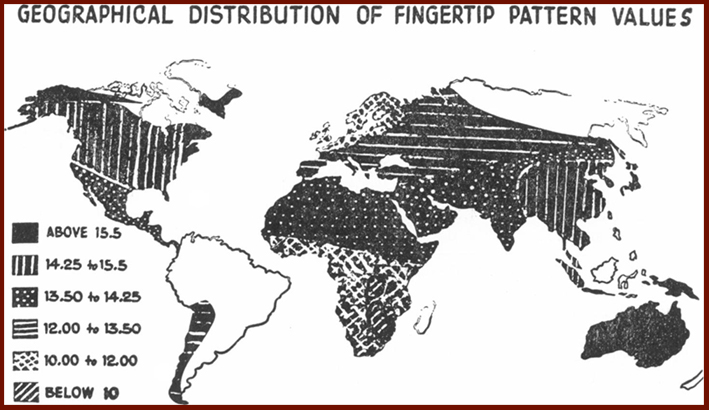Summary:
In his 1994 article in Discover Magazine, Jared Diamond argues that the traditional notion of "human races" (subspecies) based on visual features of skin, hair, eyes is not scientific. Furthermore, it is unnecessary and harmful to human society.
 |
| Race by Blood Type A? |
 |
| Race by Fingerprint Type |
It may be true that different regions of the world have some notable characteristics such as dark skin in Africa, or narrower eyes in Asia. However, Diamond argues this does not mean that humans can be categorized into clear biological groups. Depending on what biological characteristic is used (skin, blood type, fingerprints, lactase digestion etc.) the groups come out differently. Based on sickle cell malaria gene catorizations, Swedish whites will be grouped with Xhosas in Africa. That is the problem of concordance. If the groupings vary according to the trait used, there is no concordance of variable traits, and therefore defining a subspecies of humans is not valid.
Today, DNA analysis is possible, and that will clarify how various populations migrated from Africa to other parts of the world. Obviously some groups are closer cousins, like Japanese are closer to Koreans and Tibetans. However, even within Japan, similar splitting is possible. Some people in Japan have more Mongolian genes, some have more Oceania genes. It is mixed and complex. That is the problem of hierarchy. Depending on how much difference in DNA you define as "different" (0.1%? 0.2%), the number of categories will change. The criteria is arbitrary and ultimately meaningless. Clear categories of human physical characteristics based on multiple traits cannot be defined. Categories with one or two traits are easy, of course, but which traits are used is arbitrary.
In race, traditionally, beauty traits were used because that is how humans like to subjectively and culturally separate themselves. As Diamond concludes, in primitive times, such 'us and them' distinctions may have been useful for protection. In the age of global interaction, such distinctions are unneeded and harmful.
Critical Reaction:
Does this argument make sense? It seems to. However, one thing that bothers me is that the definition of "concordance" (or any definition of subspecies) is hard to find on the Internet. Do other taxonomists agree with Diamond's view? I'm curious how solid the consensus of "no human races" is.
Also, assuming his argument is reasonable, what's the application? For one, scientists in any field should not use the word "races" in a biological sense. That seems clear. However, in society, people live from day to day based on their subjective, traditional notions. Whites think they are white, and Asians think they are Asian. The concept of race is subjective and cultural, but it IS something that people feel as a social category. Therefore, ignoring it or abandoning it is not a solution.
A proper understanding of both 1) the biological fallacy of race, and 2) the social reality of race is necessary.